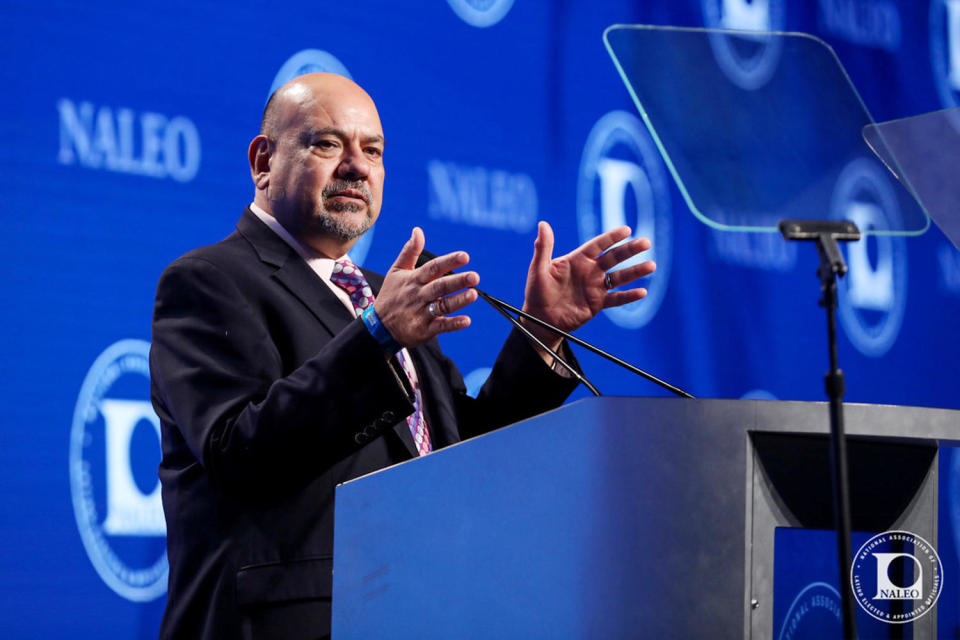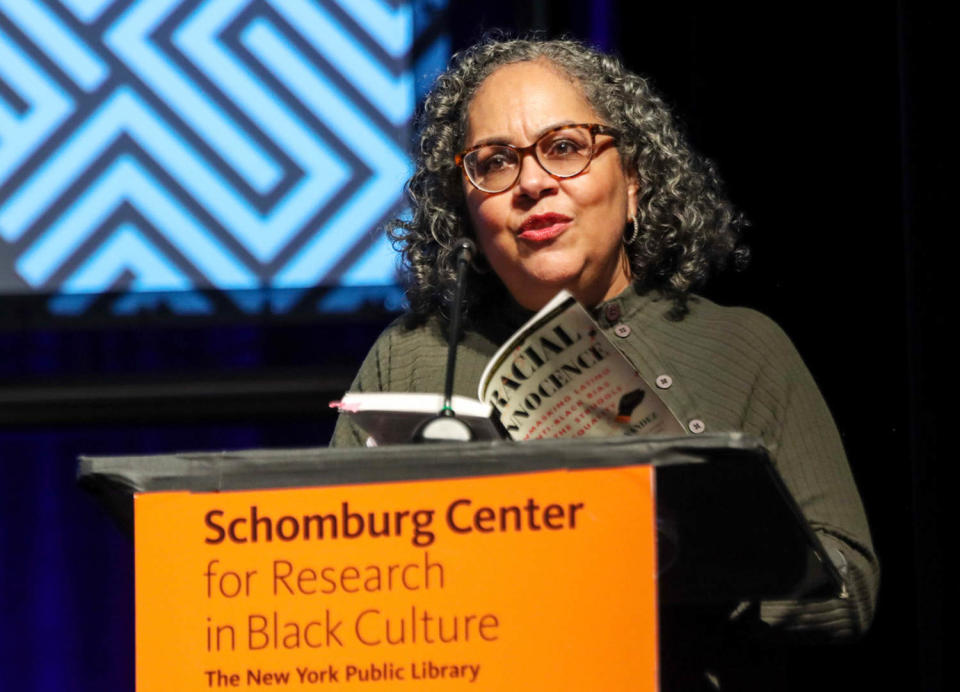Will being able to choose Hispanic as a 'race' on the census do a better job of identifying Latinos? We asked.
When Monica Sanchez fills out official forms that inquire about race, she sometimes feels annoyed by the options.
“I’m like: No, I’m not white. I’m not Black or Asian. That is basically the only options I’ve seen, including on medical documents, so I usually just choose ‘other,'" the Seattle-based speech language pathologist told NBC News.
For Sanchez, who is of Mexican American heritage, the choices on government forms make Latinos seem like an afterthought. “Choosing ‘some other race’ or ‘other’ feels like we are a P.S., like we’re not worth an actual category of our own — it’s like we are not being recognized as a human, as part of the human race,” Sanchez said.
“It’s a little thing, but it is huge to me," she said. "It’s offensive.”
For the first time in decades, the government is changing its categories for race and ethnicity data. Under new standards adopted by the Biden administration, “Hispanic or Latino” will be listed as one racial/ethnic category, and people of Middle Eastern or North African descent will have their own checkbox on forms such as the census. While some advocacy groups and scholars applaud this change, others are concerned that it will dilute the data on racial differences among Latinos.
Previously, Latinos had a two-part question for their identity in federal forms: They were asked whether they were Hispanic or Latino and then asked to pick a race: white, Black, American Indian or "some other." The issue was that many Hispanics like Sanchez didn’t see themselves as white or Black or Asian, but just “Hispanic.”
The updated method uses one question for race and ethnicity and allows people to check as many as apply to their identity.
For them, ensuring that people know they can choose multiple ways to identify, including "Hispanic" as a race as well as "Black," is key as the federal government adopts the new categories.
Many say that the old classifications weren't working well.
“In the past, the large numbers of Latinos who said that they were 'some other race' likely resulted in a distorted view of the racial identification of Latinos and other populations,” said Arturo Vargas, chief executive of the National Association of Latino Elected and Appointed Officials Educational Fund. Vargas pointed out that in the last census, millions of respondents said that they were not white, Black, Native American or Asian.

“That indicated that there was a problem with how that question was originally designed," said Vargas, who favors the revised federal approach because Census Bureau research has shown that it's a significant improvement in measuring how Latinos identify.“We want to see the bureau get out of the business of telling people what their race is, and that is what the bureau has wanted as well,” Vargas said. “We want people to find themselves on the census form and to decide themselves how they see themselves.”
For the federal government, measuring the diversity of Latino identity has been difficult. On the 2020 census, 42 percent of Latino respondents marked “some other race.” It also undercounted Latinos, continuing a longstanding struggle for the bureau to accurately count historically underrepresented groups.
This points to another problem with the former system for classifying Latinos. People who choose “some other race” or do not respond to the race question on the census are assigned a race by the bureau, said Julie A. Dowling, associate professor of sociology and Latin American and Latino studies at the University of Illinois, Chicago. “So basically we have nearly half of our community with a race that is imputed or assigned by the government, resulting in bad data.”
Dowling, who served on the Census Bureau’s advisory committee on race and ethnicity from 2014 to 2020, said that testing by the bureau showed that Latinos wanted to be able to identify as Hispanic/Latino on forms. “For a lot of people, their racial identity is a function of how they are treated by other people and how they move through the world. So I absolutely think that this new format is going to be better,” she said.
Thomas A. Saenz, president and general counsel of the Mexican American Legal Defense and Educational Fund, believes that the changes are “a step in the right direction,” because the notion of a fixed scientific concept of race is outmoded.
However, Saenz said that the government has more work to do. “We think that one (combined) question for race/ethnicity will facilitate more accurate data collection for the Latino community,” he said. “But whenever you have a new system, our view is you have to be very careful about giving people cues about the new system. We are in favor of more explicit suggestions to make sure that people know that if they are Afro Latino, they should check two boxes, not just one.”

The Pew Research Center reports that 6 million U.S. adults identify as Afro Latino, making up 12 percent of the adult Latino population.
“The Census will be using these Office of Management and Budget categories, and it’s not going to be user-friendly for Latinos,” said Tanya Katerí Hernández, professor at Fordham University School of Law and the author of "Racial Innocence: Unmasking Latino Anti-Black Bias and the Struggle for Equality," which uses legal cases to examine the way Black Latinos have experienced discrimination in areas from housing to employment to education.
“If someone just wants to check Latino or Hispanic, cool. If they want to put down their ethnicity, they’ve got space to do that.” The issues arise, Hernández explained, when Latinos try to see themselves in the subcategories, which in her view hold the potential to “erase” Afro Latinos. By inserting Hispanic/Latino as a category equal to Black, it “situates Blackness as foreign to Latino identity and ... discourages multiple box-checking.”
Census data is extremely important, Hernández emphasized, because it is used in enforcing Voting Rights Act protections, evaluating fair housing and lending practices, and in designing electoral districts.
Just marking “Hispanic” on a form can dilute important data on Latinos’ racial differences, which can then affect the collection of important information, like the gaps between rates of homeownership, income, employment and other factors between white and Black Americans, for example.
Asked if she had confidence that the federal government might tweak the census form to further improve it, Hernández said no.
“When it was time to really listen, they didn’t. They took our commentary, they said they listened to it, and then did what they were going to do all along anyway," she said.
Hernández pointed out, for example, that under countries of origin for Black or African American, they don’t include Cuba or Dominican Republic, for example, which have large Black populations.

When the new categories were announced, the OMB said that its research has shown that Afro Latino population estimates were slightly higher with a combined race/ethnicity question that also provides detailed checkboxes and write-in fields. But the working group that came up with the new categories did recommend that the issue be further studied, because about half of Afro Latinos interviewed during its research chose only Hispanic or Latino on a combined question, even though they had selected the Hispanic or Latino and Black or African American categories when they were recruited for the interviews.
A 'made-up' category?
Some conservatives are displeased with the new classifications, as well. Mike Gonzalez, senior fellow at the Heritage Foundation, is against having more categories and boxes to check on government forms.
“It balkanizes the nation. We don’t need to put Americans in boxes, we need to reconsider the boxes we have now, which are synthetic and nonsensical," he said.
“Hispanic is a made-up category,” Gonzalez said. “There is no Hispanic race. There is no Hispanic nation. There is no Hispanic DNA. So this is all a political construct, and that’s the reason I am against it.” Gonzalez described the changes as “not a grass-roots thing, it is a grass-tops thing.”
Researchers, however, have examined factors that may explain why many Latinos do not feel fully comfortable identifying as white, regardless of their skin color. In 2021, roughly a quarter of Latino Spanish-speakers said they had been criticized for speaking Spanish in public, and 20 percent of Latinos said that they had been called offensive names in the past year, according to a 2022 report from Pew Research. Among darker-skinned Latinos, the numbers reporting discrimination are much higher: About 4 in 10 Latinos said they experienced discrimination from non-Latinos as well as from other Hispanics.
About half (48%) of Hispanics in the Pew survey felt that discrimination based on race or skin color is a big problem in the U.S. Such factors likely contribute to a sense, among some Latinos, that they are not considered fully American, and thus they are reluctant to self-identify as white.
Also, hate crimes against Hispanics tend to rise when there is extensive media coverage of Latinos, particularly in the context of immigration, which can make some Latinos feel vulnerable to violence and ugly rhetoric.
A spokesperson for the Office of Management and Budget declined to make anyone available to NBC News for an interview, pointing instead to a federal register notice and a White House blog post. The notice states that a combined question format on race/ethnicity “results in higher quality and more useful data” and that the office is prioritizing research into how to encourage the selection of multiple race options by Afro Latino respondents. OMB says it is establishing an Interagency Committee on Race and Ethnicity Statistical Standards.
Alexia Palomino-Cortez, a graduate student in Los Angeles, welcomes the census changes.
“It’s actually a really great thing," she said. "It will show a better representation of who we are and how we see ourselves, rather than the box we’ve been forced to check in the past because that was all that was available.”
Palomino-Cortez, who identifies as Mexican American and Indigenous Mexican, said that when she visits with friends and family, organic conversations about race and ethnicity often arise. “I hear that a lot of people identify as white on government forms because, to them, white equals American — but that is not how they really view themselves.”
Palomino-Cortez is optimistic that the new census forms will give Latinos the chance to express their identities “in all its intricacies.”
“This is a really big moment for us," she said.
This article was originally published on NBCNews.com

